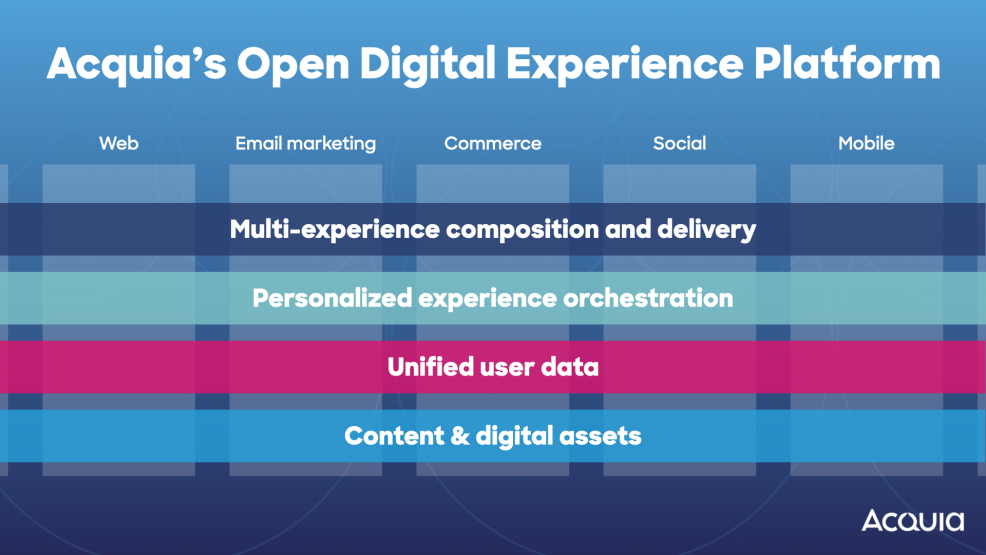
The Future of Marketing Technology: Platforms Plus Point Solutions

Former CMO of Acquia and Optimizely (Ektron), Tom Wentworth, recently shifted his stance from best-of-breed to all-in-one marketing platforms. He explained his change of heart on LinkedIn:
I used to advocate big time for the concept of a best-of-breed approach to buying marketing products as opposed to buying a single vendor platform like Salesforce, Adobe, etc. But now I've changed my mind. All-in-one platforms will win. Proprietary data sets combined with all the recent advances in AI changed my view. The massive platform datasets are just too big of a moat for all the best-of-breed vendors to overcome. [...] I think we'll finally start to see Scott Brinker's infographic get smaller.
Today, organizations use various applications in their marketing stack: content management systems, marketing automation tools, video platforms, commerce platforms, chat tools, digital asset management solutions, and more. Many organizations grapple with the issue of siloed content and data due to the complex nature of these marketing stacks. The lack of data and content integration hampers their ability to deliver an optimal customer experience, which is crucial for standing out.
Imagine an e-commerce company that sells products both online and in physical stores. If they don't connect the data from these different systems, they won't always be able to recommend the best products to their customers. However, when all the data is connected, they can better understand their customers' behavior, which will improve their sales and marketing tactics.

Think of customer data like pieces of a jigsaw puzzle. If you only see one piece (data from a single marketing product or channel), you can't really understand how customers behave or what they want. But when you put all the pieces together (integrate data from all products or channels), you get a much better picture of their desires. This helps you create a better customer experience across all touchpoints.
So the real challenge for most organizations is not to redesign their website with the latest and greatest JavaScript framework or headless technology – it lies in connecting all their data and content, and using their website and other channels to create highly relevant customer experiences.
Staying competitive in the future will mean that your digital experience applications can seamlessly act on all the content and customer data across your organization. The core concept of the Composable Digital Experience Platform, which I've previously written about, emphasizes the quick assembly of applications and utilization of all available content and data to deliver the best, most relevant, customer experience to the end user.
Tom believes that all-in-one platforms, in which he includes Adobe, Salesforce, Acquia and Optimizely, have an edge over point solutions and best-of-breed marketing stacks. As the name suggests, all-in-one platforms offer various marketing products that (increasingly) maintain a unified data layer across them. Marketers will be motivated to use multiple products from a single vendor because their products' shared data layer minimizes the necessity to integrate different data and content sources.
Needless to say, I agree on the importance of leveraging content and data across the organization to provide excellent customer experiences. As per my 2019 retrospective, Acquia began investing in a unified data layer in late 2019 and currently offers dozens of AI models on top of our data store. This was a forward-looking move, preceding AI becoming a prominent trend. Additionally, Tom and I both believe that AI, with its huge data requirements, will further expedite this trend.

Experiences need to be personalized and orchestrated across all digital channels. To deliver the best digital experiences, user profile data needs to be unified across all systems. To make experience delivery easy, all content and digital assets need to be reusable across channels.
Tom's predictions become more intriguing when he states that all-in-one platforms now have a "winner takes all" advantage over point solutions. Tom argues that when data and content are integrated, all-in-one platforms can offer unique benefits that point solutions cannot match, particularly in the field of AI. Tom even predicts that the martech industry might shrink as a result.
While I wouldn't mind if all-in-one platforms came out as the winners, I don't think of Acquia as an all-in-one platform company. We strongly encourage our customers to purchase only the Acquia products they need, while integrating with solutions from other vendors. While I see Acquia as a platform company, I consider it a best-of-breed platform rather than an all-in-one platform.
Semantics aside, the issue is that platform companies, including Acquia, don't cater to every requirement an organization has for its marketing technology stack. Platform companies don't excel at every service they offer. Consequently, most marketing stacks end up having a number of point solutions, making the integration of data and content from these diverse applications a necessity.
Imagine a retail company using an all-in-one platform with content management, email marketing, website personalization, and analytics. While these solutions meet some of their marketing needs, they might also require specialized point solutions for product recommendations, social media management, and video management. Herein lies the challenge: they need to integrate customer data from both the all-in-one platform and the specialized point solutions to create a unified and personalized shopping experience for their customers.
In essence, I certainly believe that platform companies will hold an advantage. However, I also believe that organizations will still need to establish central data and content repositories by using tools like Customer Data Platforms or Data Warehouses. All-in-one platforms will provide these as well.
If I were to place a bet, I'd wager that the winners will be open platforms offering the best core services, including a shared data and content layer, coupled with the capability to integrate best-of-breed solutions.
To be more granular, I'd bet on this:
- Every enterprise martech stack demands custom integrations and point solutions. Since all-in-one solutions are always partial solutions, there will always be a place for point solutions.
- All-in-one platforms will offer essential content and data services, such as a Customer Data Platform (CDP). Smaller point solutions will integrate with these core services and add more features on top of them. The all-in-one platforms will organize these point solutions in marketplaces.
- Almost all large organizations will need to invest in central content and data stores to harness the potential of their content and data. Central content and data stores will become a critical component of every martech stack.
- AI will accelerate the need to establish those central content and data stores.
- Both point solutions and all-in-one platforms must be open and easy to integrate, without requiring developer support.
- Digital experience analytics, customer journey orchestration, content marketing, digital experience creation and personalization are growing and long-lasting trends. However, in the next 10 years, these categories will undergo a transformation, adopting an AI-first approach.
- AI will lead to an expansion, not a reduction, of the marketing technology industry. Scott Brinker's infographic will grow bigger, not smaller. I'm betting on Option C.
This leads us nicely into discussing Acquia's strategy. I'll share more about our strategy in my next blog post.
This article was originally posted on Dri.es.


